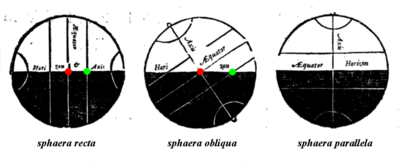Right ascension
In astronomy, right ascension is one of the astronomical coordinates used to locate the stars on the celestial sphere, equivalent to terrestrial longitude (geographical coordinate).
Right Ascension is measured from the point Aries in hours (one hour equals 15 degrees), minutes, and seconds due East along the celestial equator. The complete circumference (360º) corresponds to 24 hours. The Aries point (or Vernal point) is at the position of the Sun at the spring equinox or Vernal Equinox. The symbol for right ascension is α.
Right Ascension (RA) is measured in hours (h) and takes values from 0h to 24h subdividing each hour into 60 minutes (m) and these in turn in 60 seconds (s). For example, the right ascension of the star Sirius, the brightest in the sky, is α = 06h 45m 09s
History

The concept of right ascension has been known at least since Hipparchus, who measured stars in equatorial coordinates in the II century a. C.. But Hipparchus and his successors made their star catalogs in ecliptic coordinates, and the use of AR was limited to special cases.
With the invention of the telescope, astronomers were able to observe celestial objects in greater detail, as long as the telescope could be kept pointed at the object for a period of time. The easiest way to do this is to use an equatorial mount, which allows you to align the telescope with one of its two pivots parallel to the Earth's axis. A motorized watch is often used with an equatorial mount to cancel out the Earth's rotation. As the equatorial mount became widely adopted for observation, the equatorial coordinate system, which includes right ascension, was adopted at the same time for simplicity. Equatorial mounts could accurately point to objects with known right ascension and declination through the use of setting circles. The first star catalog to use right ascension and declination was John Flamsteed's Historia Coelestis Britannica (1712, 1725).
